My Flat Your Flat Our Place
This collection of photos was exhibited at OUSA Art Week 10-14 Aug 2009, at the University of Otago, Dunedin, New Zealand.
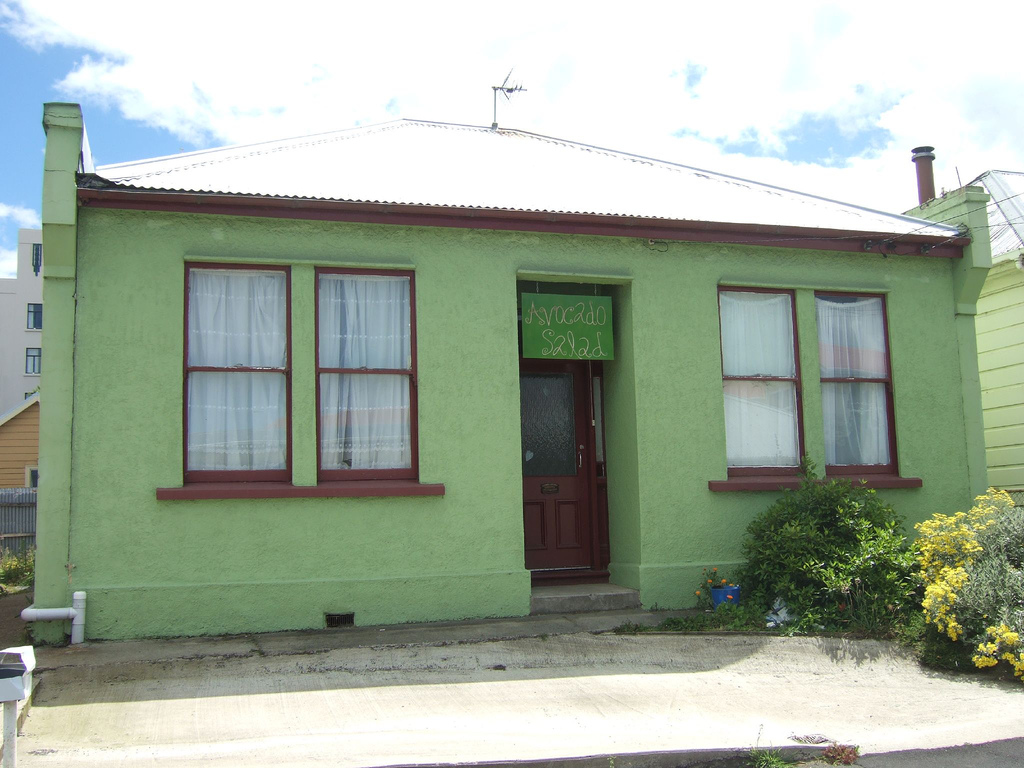
“These buildings provide a sense of tradition or history, which makes students feel a part of something more than just being a student; they are part of a history and a culture unique to the Otago student experience.” [Spurdle p146]
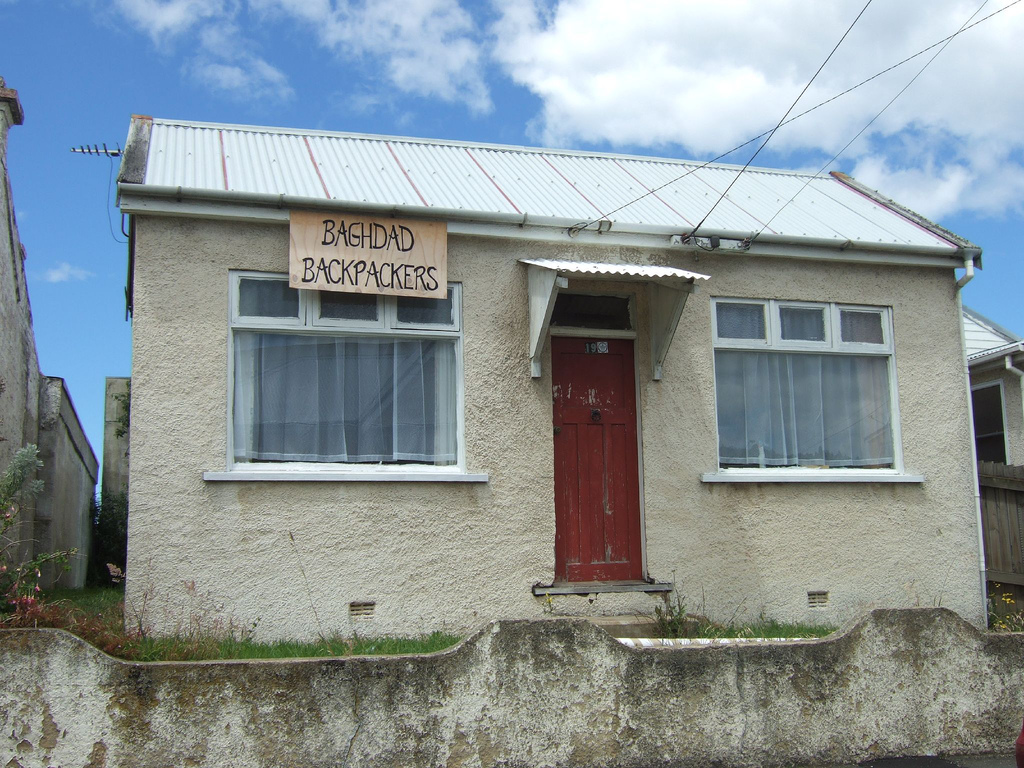
“Each flat has its own legend – they carry the memories of those gone before … Dunedin is marketed internationally as a heritage city. The student traditions, heritage, and history of the unique elements of the city and the student flats in particular are so much a part of that, not just the historic old campus buildings …”[Respondent P913, Spurdle p118]
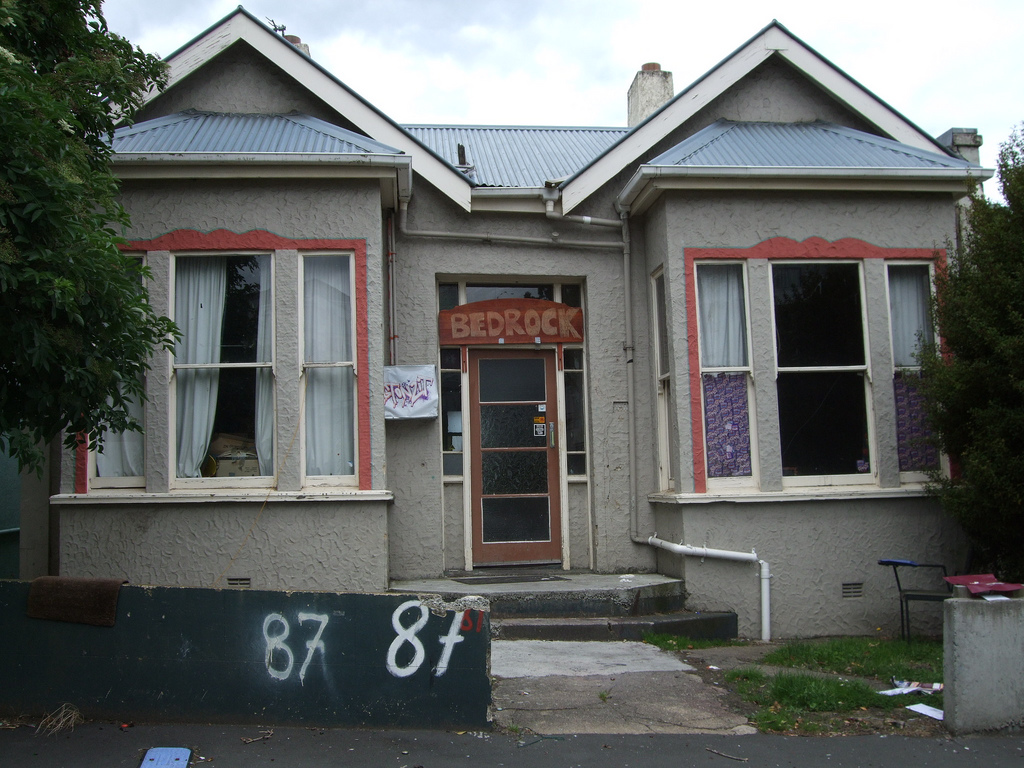
“Too many large faceless flats in Dunedin – long my areas such as Clyde St and Castle St survive. “[Paul Thompson]
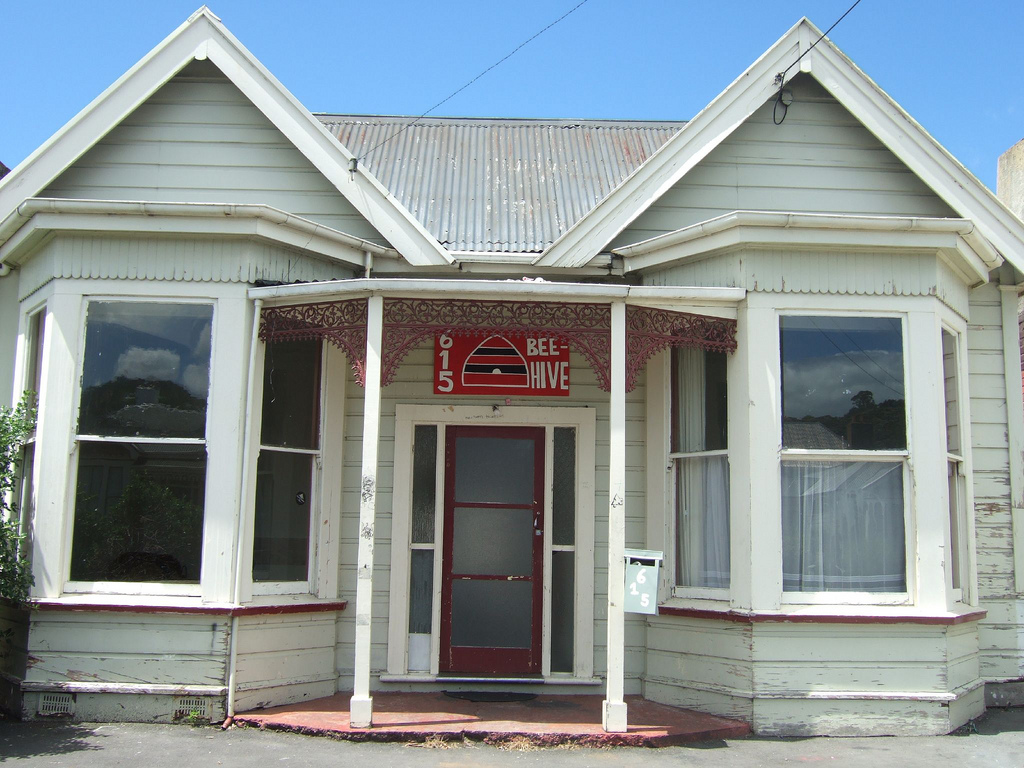
615 Castle Street “Naming a flat is a lot of fun, people know here you live! Currently I live at the Beehive a notorious flat in the heart of Castle Street. People know the flat because of it’s name and I am proud to be a member of it. I would hope that the Beehive name will be passed on for many years to come. It is a lovely scarfie flat, has a lot of heart and has hosted some outrageous parties over the years.” [Harry Urquhart-Hay] “Lived in that shitbox Y2002. Housing inspectors found the wasn’t ‘earthed’. Lucky it was so dank, otherwise it would have gone up like a tinderbox. Big Mike, GG, Dave, Ferret and myself managed to cultivate a lone mushroom in the filth on the bathroom surface – hope subsequent tenants took good care of him.” [Duncan Blomfield] “Just went by last night and the sign was down!!!!! what the fuck ay! So I went in and blasted them with abuse. They said they would put it up again … otherwise I vote that we take action.” [Connor Archbold]

“Over the years of student occupation, a number of flats have inherited names that are passed on with the flat. Although similar, flats are made distinguishable whether through exterior paint or the name … students personalise their character flats through names and colour to create their own meaning which determines the ‘vibe’ or feeling in North Dunedin.” [Spurdle p117]
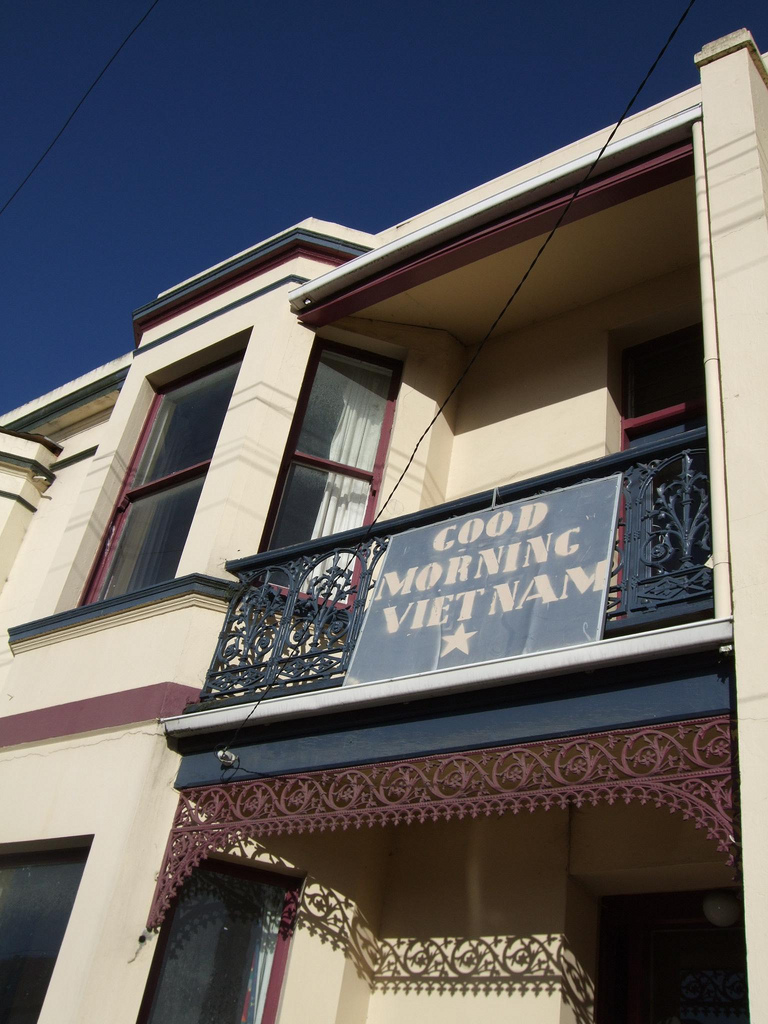
“It was a Vietnam themed party, and this sign was created … by Will, Karam, Paul, Vanessa, Reanna and Me … for a flat warming back in 2002” [Sarah Ellis]
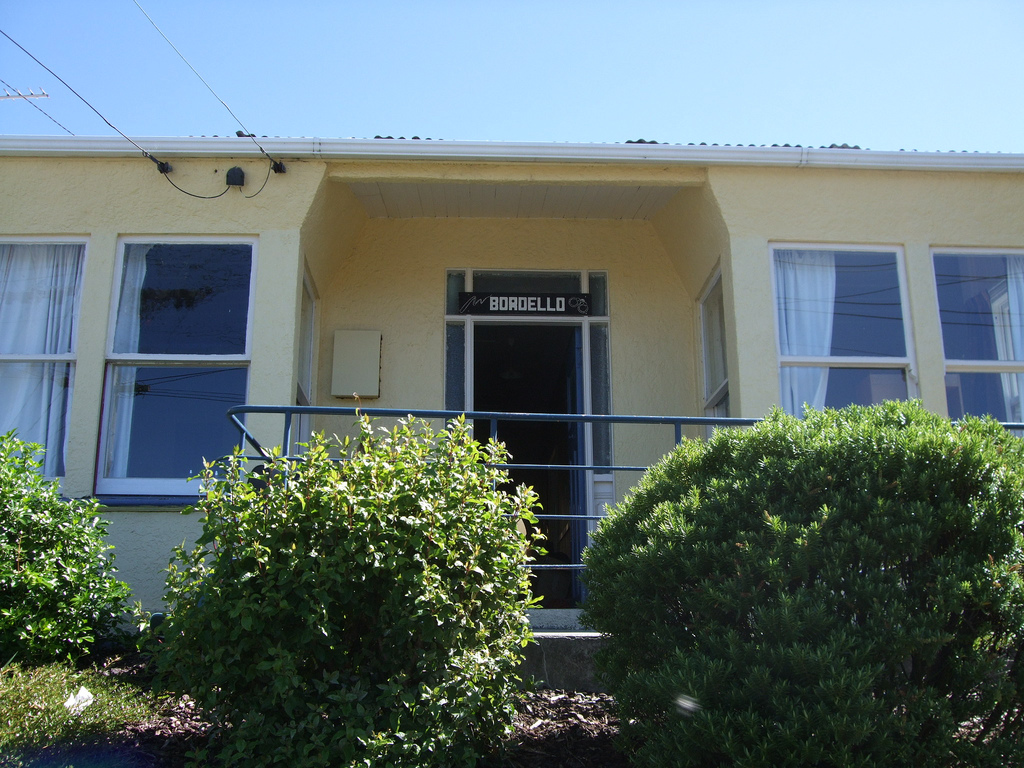
“The Bordello has only been in existence for 7 or 8 years, but I’d like to think it would hang around. It was previously called Loch Ness but I’m not sure what happened to that name – it didn’t have one when we moved in. I wonder if renaming a flat is like renaming a boat…” [Jamie Bell] “[The name] fitted with the kind of lifestyle five young guys in the heart of Dunedin wanted to live, also one flatmate had an obsession with Tales from the Crypt (see Bordello of Blood). [Jamie Bell]
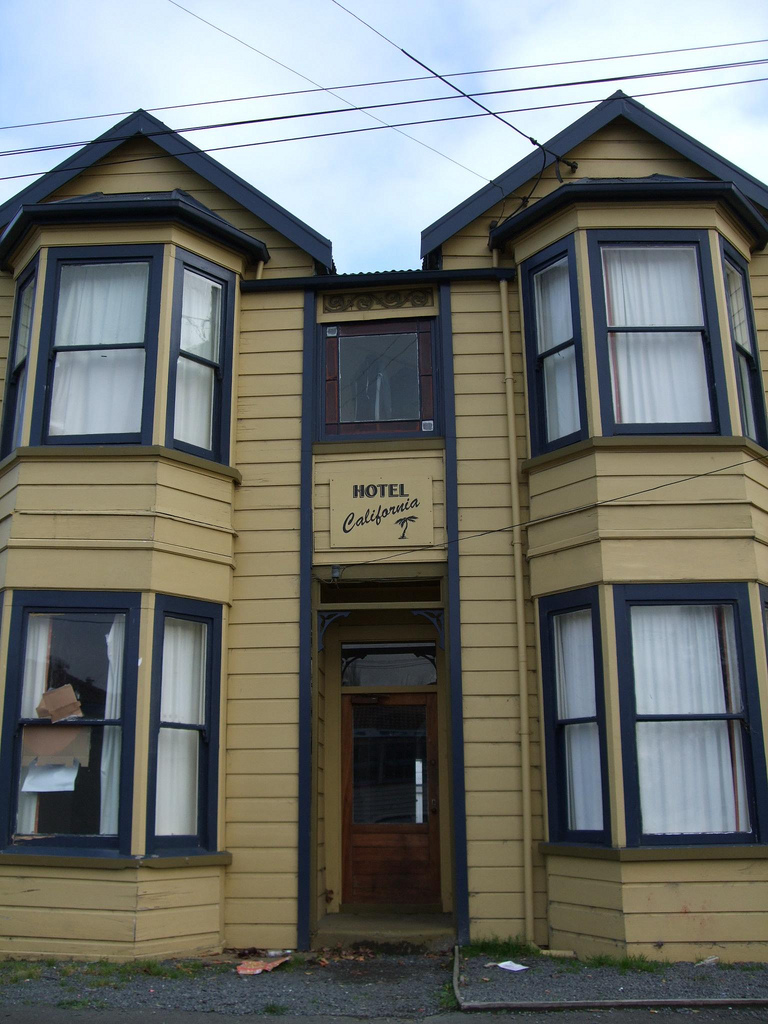
6 Riego Street “I think it’s important that flat names are documented as they do form an important aspect of the student subculture – with the number of people moving in and out of places, it’s amazing they don’t all get renamed every year. In that way it’s nice to see tradition carrying on.” [Jamie Bell]
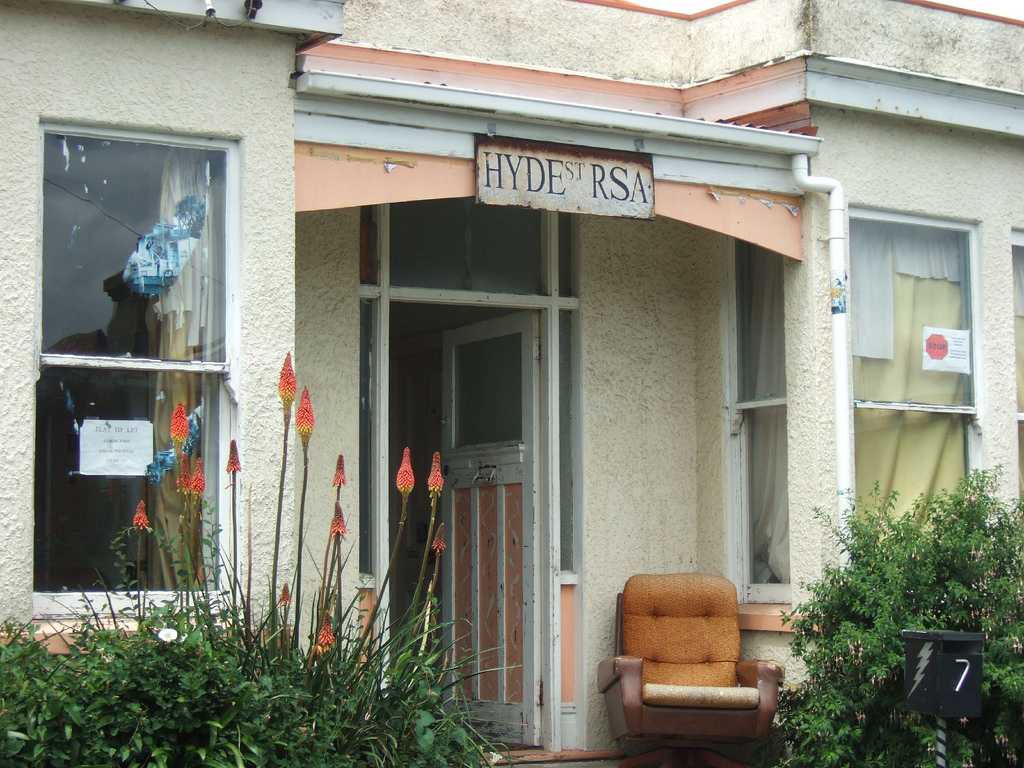
“Hyde St – Keg themes, easier then addresses, streets are too long, landmarks. The students have something to live up to, a show to put on to entertain the flats surrounding, a reason to show pride in their house, and to entertain to a certain degree.” [Sarah Barnett]
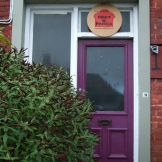
It creates a lifestyle and expectations that those who walk past it expect to see. It becomes part of the life of the flat. The flat takes on a life of it’s own and specific type of students live in certain flats.” [Sandra Jensen]
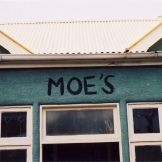
“One of the better-known flat identities … named after the bar on the television cartoon series The Simpsons. This, though is about to be upgraded to Flaming Moe’s, after the fiery cocktail invented on the show, and thanks to a friend at art school the new sign is ready to go. So proud are these residents of where they live, they requested a word-number from Telecom and are listed in the student phone directory under 477-MOES.” [ODT 14.05.99]
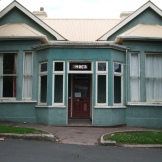
“I remember the day we named this flat… back in ’97… we always meant to put “flaming” above the left corner… never did get around to that …” [Paul Thompson]
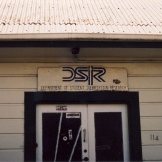
“Two of the best years of my life were spent in the DSIR (114 Union St). We named it as part of the 96ZM Name Ya Flat competition, which we won our division. Long may the name live on!!!!” [Clay Davies] “DSIR won the R21 category (made sense before the drinking age was lowered) ;)” [Brad Eales] “DSIR (Department of Student Inebriation Research). My girlfriends dad worked for the actual DSIR (Dept Scientific and Industrial Research), so a clever play on the well known organisation. Ironically two of us went on to work for IRL (who came out of DSIR) once we graduated!” [Tijs Robinson]
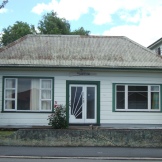
“DSIR was established by a group of 5 guys, they even had a lab coat each for when they had drinking sessions, and one of the guys painted the emblem on his car.” [Korina Richmond]
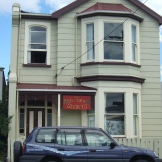
The Chamber of Secrets won the Te Roopu Maori Best Name or Sign in OUSA’s 2007 House & Garden awards. “The judges thought the sign on this flat was ‘Fucking awesome!’. The Chamber of Secrets was very well executed and well engineered, they said.” [Judges comments] ~ Named for the second book in the Harry Potter series, the name was suggested by a friend but painted by one of the flat mates, Will. An other flatmate, Oliver recorded the unveiling of the flat on video – a joyous 19 seconds! The sign was reclaimed after new tenants to the Albany St flat didn’t want the sign, and it hangs on the lounge wall at the Chamber Boys’ current flat.
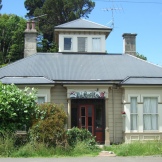
“We just say, ‘The Castle’ and everyone knows what you mean” [Anna McWilliam in ODT 02.05.09, p1]
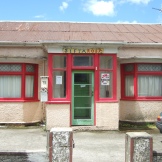
“A few years ago I flatted on Clyde St – the flat namely “Sifta Rosa”. I think that has been it’s name for a while now. I always wondered what it meant and what the tenants were like who gave it that name.” [Vasuda Mistry] “That was a lovely flat, it’s all about barbeques in the lounge. Is it still called that? I wonder where it came from …” [Clare Hayward]
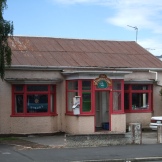
“For the university student community, character flats are more than homes, they are a representation of a valued time in people’s lives, of stories, memories, traditions, and experiences associated with their student life. Each flat has it[s] own legends or tales that form a collective value, sense of place that creates a distinct and special atmosphere, felt both by past and current students.” [Spurdle p146]
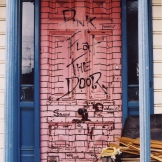
“In this flat there’d be one rule: there were none! It was a magpie’s nest, a mishmash of free-thinking young people who got together. It wasn’t a drinking flat, it was a talking flat. Smoking cigarettes and drinking tea, talking all the way through to 5.00am.” [Wallace Chapman interviewed by Matt Nippert The Listener Nov 18-24, Vol 206 No 3471] “I lived in ‘pink door the flat’. Everyone knew where you were flatting by just saying ‘the pink door’.” [Paul Harvey]
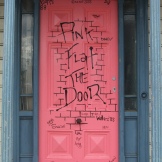
“20 years later that flat [Pink Flat the Door] is still a catalyst for connecting us, and while our lives have changed, the motivations that guided us then still seem to have relevance.” [Swani Harris] “The door, perhaps controversially was totally stripped and reworked and repainted, so now arguably the Pink Flat door has now gone. But in its place stands a new door in ultra bright fluro-pink with further signatures added …” [Wallace Chapman]

“For a large number of students, their experiences at Otago are intimately bound up with life in the character buildings of North Dunedin. If they are lost, student life will inevitably be greatly changed.” [Respondent P1206, Spurdle p132]
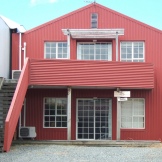
“I have invested in flats; named flats have the reputation of being more troublesome in terms of damages, but better in terms of reliability of payment because they are students with allowances as opposed to young people with part-time employment.” [Grant McKenna]
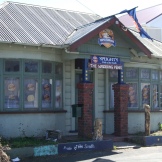
“Naming our flat was definitely a way for us to identify ourselves inside Dunedin’s student culture. I don’t think the name itself was that central, it was more the fact that we did take the trouble to name the flat that I think made us stand out.” [Dan Williams]
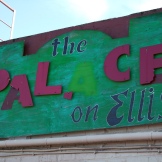
The sign cost $45 to make. The idea for the name came from the pub in the movie, Once were Warriors. “The guys were so proud of their effort that when the sign was first erected, they also nailed up a replica yellow AA sign on the lamp post on the corner. ‘But we got dobbed in and had to take it down’ … a lack of resource consent was apparently to blame.” [ODT 14.05.99] “To the current flatties in The Palace On Ellis – I was one of the ‘originals’ in 1999. Would be great to see the sign restored to it’s former glory.” [Steven Young]
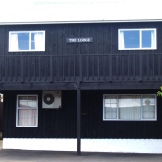
“Does NZ have a culture of Fraternities and sororities … sort of … but not really. The student flat and the naming of it is similar to the fraternities and sororities culture in the US. I had watched King Frat (and still have it on DVD) when I got to University in 1988 so I suppose I was looking for something like that. Or rather, was expecting something like that. When it didn’t appear, we invented it.” [Gerald Speers]
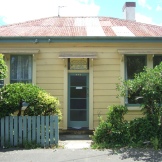
“Flats often have something imparted to them by previous tenants, which provide a sense of place and give the area colour and humour. Knowing that within these same flats, generations of students have encountered the same challenges, lived the same experiences, and fostered the same friendships support this sense of place, which is not the same nor can it be generated in new flats.” [Spurdle p123]
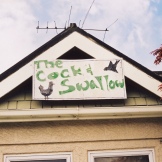
“Character flats are important because that is what the culture is. You live with the Indians on the plains you live in a tepee, you live with the Eskimos on the ice you live in an igloo – some flats probably have the same level of heating, but the culture of being an Otago Student is to live and co-habit in a Dunedin villa. The history and tradition has a lot to do with it, many others before us have lived in these villas and for 125 years a sense of tradition and culture has developed. This is something that you cannot create or manufacture, no matter how hard you try” [Respondent P890, Spurdle p155]
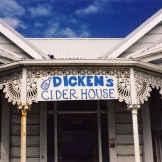
“You only have to take a trip down Clyde or Castle St to see that naming flats is now almost a rite of passage; something [Wallace] Chapman believes the pink-doored flat may have helped to institute. Maybe I should be thanking him for the glorious years spent in the Frottage Cottage or the Dickens Cider House, then.” [Ben Fahey ODT, 01.10.05]

“My god how long was this around for and what was the address?? We had a flat and sign that looked exactly like this but was in 2004 … a friend made us this sign as a flat warming present. 116 Gore Place, off Dundas by the entrance to the Gardens.” [Ursla Wiig] ~ It appears that this sign may have either moved addresses, or Ursla’s friend may have seen the original Frottage Cottage sign.
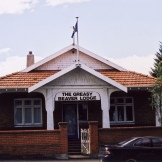
“My favourite [flat name] would have to be the “Greasy Beaver Lodge on he corner of Dundas and Great King circa 2002-03. Proudly displayed to all the traffic traveling up SH1. [Ian Auld] ~ A recreation of The Greasy Beaver was featured in Scott Eady’s exhibition “Signs” at The Blue Oyster Gallery in 2002.
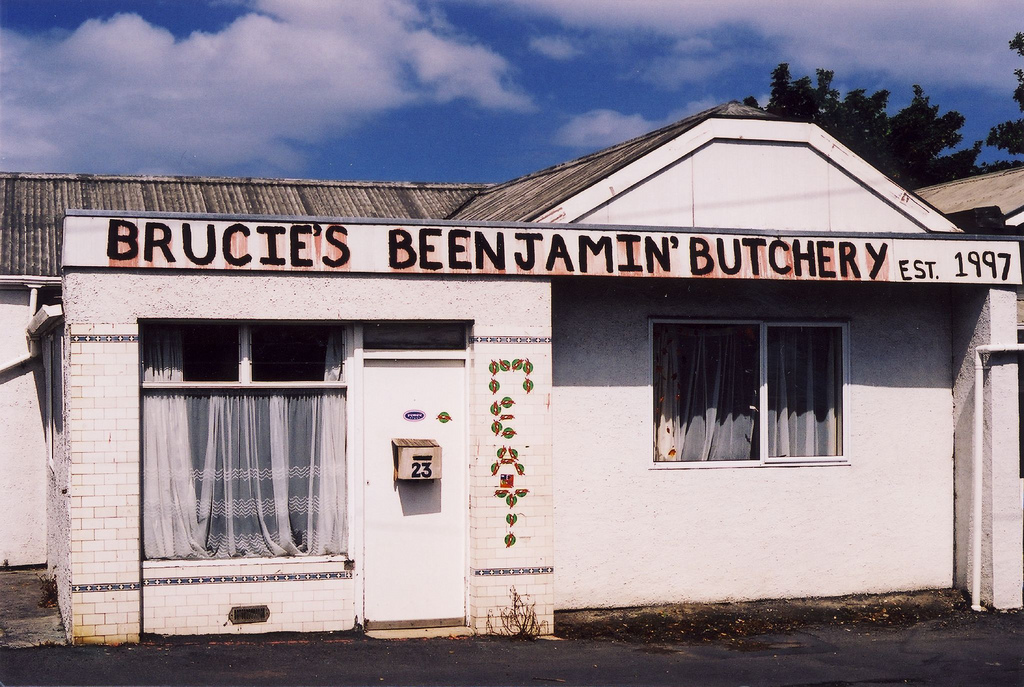
“It was originally a butchers shop. My room was the one here with the biggest window – I’m sure where the butcher used to display all the meat! Yummy! … and Bruce was/is the name of the landlord. I moved out after one year of living there (1997), but all my flatties stayed on for another year or two and they made this sign in 1998. The name mixes the landlord’s name, the name of the street, and the fact that it was a butcher’s. I think they had a moment of genius one night when on the drinks! :)” [Sarah Kaye Wilson] Regarding the 96ZM stickers. “This is the sticker that had to be visible to enter their ‘Name Your Flat’ competition … “ [Brad Eales]
The creation of identity and a sense of place was not at the forefront of my mind in 1991 when my flatmates and I named our flat Mouse House. It was because we wanted to name it something, and because our flat was infested with mice. Nine years later, an exploration into the history of print culture in New Zealand while studying at Victoria University provided a lens through which to view the ephemeral nature of the student flat names, names that colourfully dotted my then community of North Dunedin. Some names endured but many instances of this print phenomenon were fleeting. I was intrigued, and continue to be, by the names, the materials used to build the signs, and the stories behind them.
I’ve been taking photos of these flats for ten years. I’ve selected a small number here try and reflect the range of ways people have named their flats over the last decade. Some are beautiful, some are disgusting, some are witty, some are puerile – but all are creative, inventive and reflective of the individuals that made them, and those who came after; those who respected their efforts enough to keep these signs, or restore them, or rename them … or replace them with something of their own imagining. The names themselves are generally reflective of contemporary political or pop culture, some are sexual in nature or are evocative of drinking behaviour. As to their physical nature, sometimes the signs are professionally crafted, sometimes they are hand painted, sometimes they are spray painted on the fence or written straight on the window in vivid. It varies.
Distance and nostalgia provided me with a different perspective on the experience of flatting, and in particular, flatting within the immediate campus environs. This is a unique environment – the highest rental area in the country, a suburb of “young ‘uns” all experiencing living away from home for the first time. It has struck me, on reflection, that there may be more to naming a flat than just having a bit of a laugh. The naming of flats occurs for many reasons: inarguable because it’s fun, but latterly, because it is perceived by some of the residents of North Dunedin that this is a tradition, that it is part of the culture of being a Scarfie.
Your perception has become a reality, it has become a tradition. It is one of those “colourful” aspects of student culture that is presented to the rest of Dunedin society, it’s a display of individuality, a mark of identity.
We all come from some place, and we all live in some place. Our identity and our very sense of authenticity, it seems, are inextricably bound up with places we claim as ‘ours’.
Excerpt: Gentry, Kynan. “Place, Heritage and Identity” in Heartlands : New Zealand historians write about where history happened. 2006 Auckland pp 13-26.
Naming flats is about creating a home, an identity, a sense of place. This exhibition is about this place, North Dunedin. A home away from home. It’s about being here, and being part of something incredible. You’re part of it. You’re living it everyday … this is My Flat Your Flat Our Place.
Like this:
Like Loading...






























